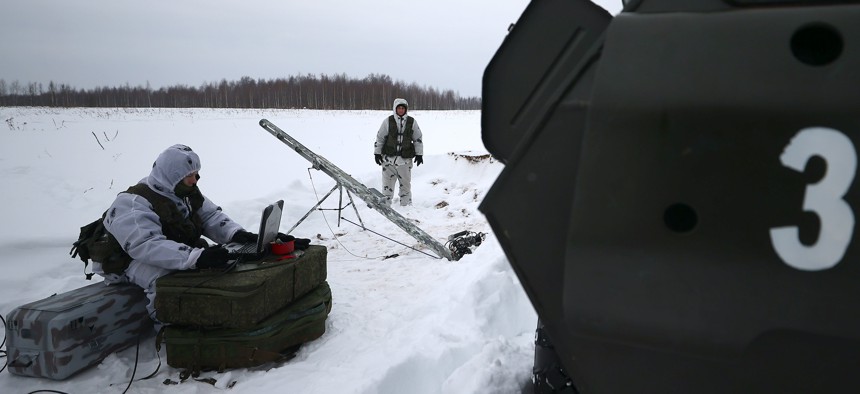
Russian troops use an Eleron-3 reconnaissance and surveillance UAV during combat patrol and anti-sabotage drills, Jan. 28, 2022. TASS via Getty Images / Vladimir Smirnov
Where Are Russia’s Drones?
The Ukraine invasion offers scant evidence of the Russian military’s hard-won prowess with unmanned aircraft.
Among the mysteries of Russia’s slower-than-expected advance into Ukraine is the apparent absence of the kind of small drones that Russian forces have put to increasingly good use in recent campaigns and military drills. But there is still reason to believe that Russia’s drones are being more widely used in Ukraine than is realized, and that their effects are being masked by other flaws in the current campaign’s execution.
Over the past decade, the Russian military has built up an arsenal of reconnaissance drones. They have also developed doctrine and skills by using the drones in Syria, Nagorno-Karabakh, and in eastern Ukraine. Under their standard concept of operations, UAVs act as airborne “eyes and ears”: observing surrounding territory, relaying data between commanders and deployed forces, and identifying and tracking targets that can then be destroyed by anything from an infantry fire squad to a tank to an artillery brigade to a warship.
So if the Russian military is starting to rely more and more on UAVs, why hasn’t their presence been reported over Ukraine? Over the past five days, Russian military columns appeared to walk into ambushes, with small units and groups of vehicles maneuvering in order to avoid larger Ukrainian military forces. These small detachments appeared to be without support—evidenced by so many social media posts—and suffered casualties. The ISR drones described above are supposed to prevent these losses from taking place, by providing a view of the battlefield and allowing soldiers and commanders to make educated decisions about their next steps.
Why was the Russian military’s initial advance accompanied by so many recorded casualties? There are many possible reasons—among them, preparation, training, motivation—but the seeming lack of ISR assets like light drones may be another contribution. Despite different UAV types available for many missions, the initial Russian drive into Ukraine did not feature the type of situational awareness that such drones are supposed to provide, at least the way Russian military practiced over the last decade.
One reason might be that the Ukrainian air defenses and electronic warfare networks seem to still be functioning so far, which could be interfering with Russian efforts to put its drones to use. Another is that despite the Russian military’s previous success with smaller UAVs, its acquisition of larger and more capable drones has only recently been cleared by the defense ministry.
Or perhaps we’re just not seeing the drones. Belarus President Lukashenka recently said that reconnaissance UAVs operated over Ukraine in the early hours of the Russian invasion.
It is likely that despite the extensive number of recorded videos shared on media, most observers are simply unable to catch a glimpse of these rather tiny aircraft. Most Russian military drones are relatively small, light models; and some are even designed to be launched by hand. The drones that make up the bulk of Russian ISR fleet—Granat 1, Granat 2, Eleron-3, Zala models, Orlan-10, Takhion and Zastava—are small enough to basically “disappear” once they rise to a typical operating altitude of a mile to a mile and a half.
We also have to assume—until contrary evidence emerges—that UAVs being used where Russian military is having greater success: with units that are advancing north from Crimea. The Ukrainian military itself said on Feb. 24 that it was using counter-UAV systems during the heavy fighting around the Azov port of Mariupol, indicating that some form of Russian drone activity was taking place.
Don't miss:
The Ukrainian military also appears to be using its own drones. Still images and video purport to show Turkish-made TB2 combat drones striking several Russian convoys. The unexpectedly robust defense also suggests that ISR drones are being used to identify and target advancing Russian forces, although no open-source evidence of this has emerged.
At this point, Russian military experts and observers warn that much can change still in the coming days, with Russian troops appearing to reorganize and tighten their logistics and supply lines. The next few days will tell whether the invasion force is correcting its performance.
NEXT STORY: Defense One Radio, Ep. 95: Vlad the Invader



